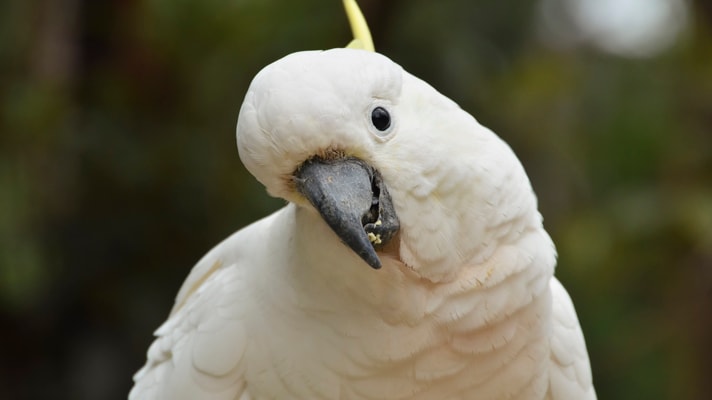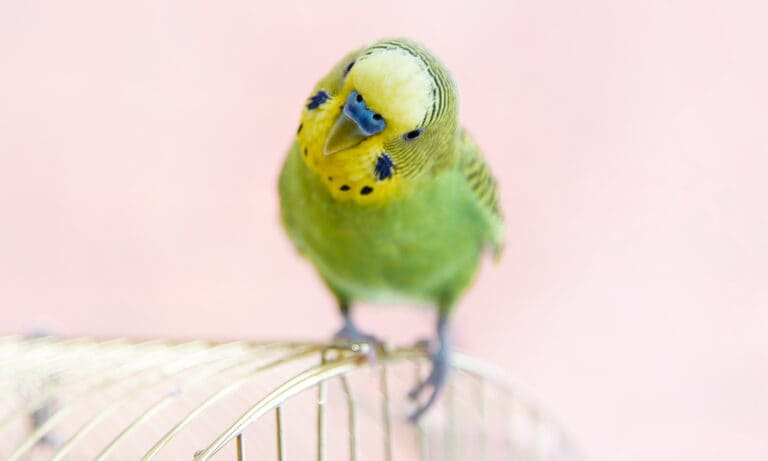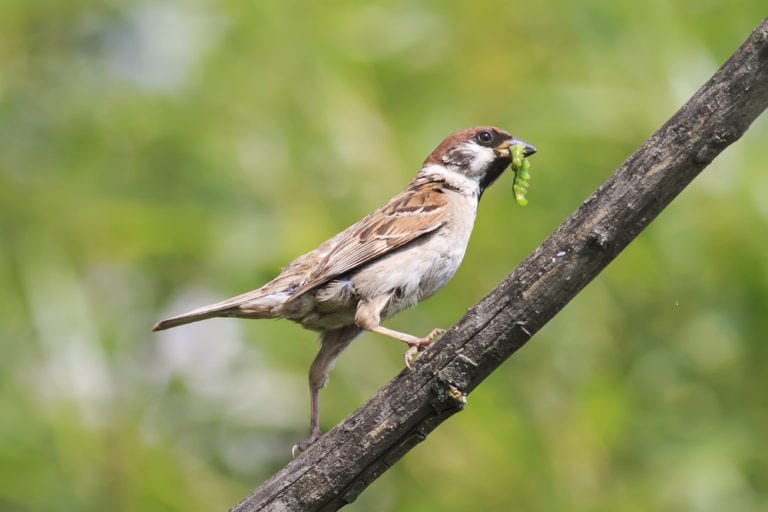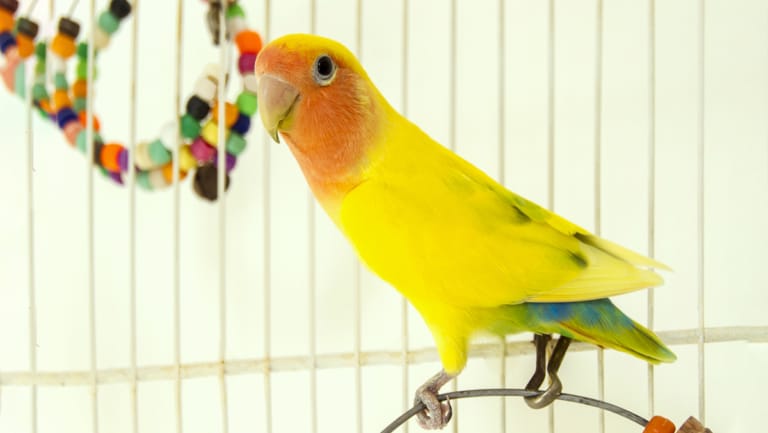People say that eyes are the windows to a person’s soul; bird people say that bird poop is the window to a pet bird’s health, and it’s true. Pet bird lovers may be more familiar with poop than all other pet owners combined. We not only keep a close eye on our bird’s poop, we get pooped on — and we learn not to care! We clean poop off with an “it happens” attitude that even the most studied Zen masters could appreciate. Here are some “poop experts” chiming in on 10 fascinating facts about the ubiquitous substance in all of our lives.
Why Doesn’t Bird Poop Smell?
“Bird poop usually does not smell like mammal excrement for several reasons. First, the avian diet generally consists of less meat and more fruits and veggies,” said Karen Zielezienski, DVM, of the Plantation Animal Hospital in Plantation, Florida. “Secondly, meat protein is rich in sulfides, which is why mammal poop is usually more smelly. In addition, many mammals, like dogs and cats, have anal glands near their anus, the contents of which emit a foul odor.” Greg Burkett, DVM, board-certified avian veterinarian and owner of The Birdie Boutique in Durham, N.C., added that parrots do not have a cecum (the pouch connected to a mammal’s large intestine) and do not have fermentation in their gut, so gas and odors are not produced. Lucky for the birds!
Do Birds Eat Poop?
“This is a very rare problem,” Burkett said. “Coprophagia, or eating feces, is recognized in many other animals, including humans, and generally goes without a diagnosis. It’s thought to be because of a nutritional deficiency in some cases; however, it’s considered a behavioral problem in most cases. Rabbits produce a special dropping that is high in B vitamins, and they are known for eating this part of their fecal waste. Turkeys and chickens engage in a similar behavior. It’s common for pet birds to engage in a house-cleaning technique where they use their beak to crumble dry poop to remove it from perches or cage grates. In these cases, they are not ingesting the poop.”
How Can Bird Poop Be Used?
“There’s a lot of nitrogen in the white portion of bird droppings, and it acts as fertilizer for the ground,” said Stephen Vantassel, project coordinator for wildlife damage management for the University of Nebraska at Lincoln, School of Natural Resources. “Humans have mined fertilizer on islands that were heavily populated with waterfowl and oceanic birds, where feces collected over the decades.” Closer to home, chicken farmers have found a way to “go green” using one thing they have a lot of: chicken poop. “One of the uses of chicken poop is as a fertilizer because it’s rich in nitrogen,” said Doug Inkley, certified-wildlife biologist and senior scientist at the National Wildlife Federation in Reston, Va. “It’s one of the contributing factors in pollution in places where there are a lot of chicken producers, but if it’s processed and distributed in the right amount, it can be used as a fertilizer.” Even though poop is a good fertilizer for plants, Inkley warned against using your parrot’s poop in your garden. “Fertilizing with your bird’s poop can potentially introduce an exotic disease into the domestic bird population,” he said.
How Does Bird Poop Affect The Environment?
The earth knows how to deal with poop of all kinds; in the earth’s natural state, its ecosystem works flawlessly. Problems tend to arise when the ecosystem is interrupted. “In the wild, bird droppings fall onto the ground, into the trees and into the water, where the microorganisms that break it down are in abundance,” Inkley said. “In the city, when it falls onto a lifeless surface, such as cement, there are very few microbes there to break it down, which is why you sometimes see large accumulations of poop from pigeons in the city.” In order to fly efficiently and quickly, birds need to carry as little weight as possible, so they evacuate their cloaca frequently. Vantassel said that the urea in bird poop is acidic, so it can deform and deface buildings over time. “In Europe you’ll see old marble statues eaten away after years of birds roosting on them. There’s even a suspicion — I don’t know if it was ever confirmed — that the bridge in Minnesota that tragically collapsed [in 2007] might have been weakened by bird droppings. It takes a long time to happen, but think of it as accelerating the rusting process.” Another issue with allowing bird droppings to accumulate in massive quantities over time is histoplasmosis, a naturally occurring fungal infection that affects the lungs and other organs. People who work around pigeons doing pigeon dropping remediation (cleaning out years of accumulated pigeon poop) or pigeon keepers are much more susceptible to this infection than the average parrot or canary owner. “It’s less likely to occur in people owning captive birds, and it’s a question of quantity,” said Vantassel. “Has there been a failure to clean the droppings? Is it being stirred up? Infection is also a function of the immune system. Let’s say someone is going through chemotherapy, which makes it harder for the person to fight off infection. If you had feces with histoplasmosis [fungus] in it and were stirring it up and the person breathed in a sufficient quantity, their body might not be able to fight it off. It’s theoretically possible, but it’s more likely around outside birds, not people who have pet birds, unless they have a lot of pigeons outside in a roost. It’s generally not an issue.”
What Do The Different Colors Of Poop Mean?
The color of a parrot’s poop can instantly indicate health status to an avian veterinarian or a seasoned bird keeper. “The normal color of bird feces is green — a nice, even green, maybe kelly or grass green, maybe a little darker, maybe even olive,” Burkett said. “If the green becomes very dark green to black, this is an indication that the bird is not eating and only bile is coming out in the droppings. “Urine should be clear,” Burkett continued. “Urates are normally white, but can become yellowish-green from bile staining, usually associated with disease, often liver related, but can be from other diseases, too. Urates can become red with blood in cases of lead poisoning,” An increase in the volume of the liquid portion, or urine, is called polyuria and may mean diabetes, excessive water intake or kidney disease. How the poop is formed is as important as its color, according to Burkett. “Bird poop has three components: a green portion, which is the feces and comes from the intestines; a white portion, which is the urates and comes from the kidneys; and a liquid portion, which is the urine and also comes from the kidneys,” Burkett said. “In a normal poop, the green and white portions are close to equal amounts, and there is just enough liquid to make it glisten with wetness, maybe a little halo around the poop if it’s on an absorbent surface. The poop will have a stiff, but soft consistency, enough to keep its form, make a tight swirl, and stay where it drops. The size of the droppings depends on the size of the bird. “Each of the three different parts of the droppings can change independently, in conjunction with, or as a result of changes in any part of the droppings,” Burkett said. “For example, if there is excessive urine (the liquid portion), the droppings will be wet, but the consistency of the fecal portion can remain unchanged. However, the presence of too much liquid will cause the fecal and urate portions to ‘unswirl’ and appear loose, but the consistency will not be changed. This is called polyuria, not diarrhea. “The fecal portion can change also in consistency, independent of any other changes in the droppings,” Burkett continued. “For example, if the feces has no form and the consistency is more like pudding, this is true diarrhea, and this can happen with no change in the other two portions of the droppings. Another example is if the droppings have large portions of undigested food material, such as whole seeds, which can be an indication of a digestive problem, such as avian bornavirus infection (PDD). Other illnesses can cause this, too.” Changes in color and consistency can indicate illness, but don’t panic if you see a change. Watch your bird’s droppings, and wait for a few stools to pass, said Zielezienski. If they don’t improve, take your bird to the veterinarian. “Temporary differences in a bird’s stool may indicate a change in diet or a change in the bird’s behavior, such as chewing on a new toy with dyes, for example,” Zielezienski said. “Increasing fruits, vegetables or colored pellets in a bird’s diet may cause the poop to be more watery or strangely colored.” Many conscientious pet bird owners find themselves at the avian vet’s office because of a change in their bird’s dietary habits. “My lovebird, Zoe, was a baby and eating just fine,” said Fran Amoroso, a bird owner from N.J. “The next day, her poops were all red, and I nearly had a heart attack. I put her into a carrier and rushed to my vet, positive that Zoe was going to die any moment. My vet took us in, Zoe provided a poop sample, and my vet looked at it and asked, ‘What kind of pellets do you feed her?’ I answered they were fruti-colored pellets. He assured me that Zoe was fine and would probably eat the other colors when she ran out of red, but maybe I would like a tranquilizer.”
Is Wild Bird Poop A Concern?
“Poop from wild birds can transmit psittacosis and even tuberculosis to pet birds, as well as some internal parasites if ingested, and should not be allowed to come into contact with your pet,” said Donna Garrou, owner of the BirdStuff Store in Orange, Calif. “Outdoor cages should have solid roofs to prevent poop from entering bird enclosures, and food and water dishes.” Zielezienski said that keeping birds outside exposes them to more diseases through wild bird feces. “Wild birds often carry more disease than companion birds and may shed a number of these organisms in their feces,” she said. “Pet birds’ immune systems may be less capable of fighting off these diseases. Pet birds that are housed outside are more likely to be exposed to these diseases, as many of them are airborne. This means that, even though your bird is on a screened-in porch, it may still be getting exposed to wild bird ‘stuff.’”
How Long Can Poop Be Left Uncleaned Before It Becomes A Health Hazard?
“Bird poop is not inherently dangerous, even pigeon poop,” Burkett said. “However, if poop is left for long periods of time, it will grow bacteria and fungi, which, when dried, can become aerosolized with flapping wings or cleaning, and be breathed in, resulting in respiratory disease. Also, large accumulations of poop can release ammonia in large amounts and cause respiratory disease. This can lead to lung infections, sinus infections and other respiratory problems. If a bird is carrying a disease such as [psittacosis], then it is passed on the droppings when the organism is being shed and causes infection in other animals and people. Generally, parrot owners are not at risk for respiratory disease if they have healthy birds and keep the cages clean.”
How Often Should Your Bird Poop?
“The number of times a bird poops in a day loosely correlates to its size,” Zielezienski said. “Smaller birds eliminate more frequently than larger birds. A budgie may excrete 40 to 50 times in a day, whereas a macaw may only go 15 or 20 times.” Burkett said that birds poop so frequently because they have a high metabolic rate and process food quickly. “In order to fly efficiently and quickly, birds need to carry as little weight as possible, so they evacuate their cloaca frequently.”
How Much Should Your Bird Poop?
The amount of poop depends on the bird’s size and should be relatively consistent. “If the volume is less than normal, it usually indicates that the bird is not eating,” Burkett said. “If the volume is larger than normal, you have to determine which part of the droppings have increased. If only the green portion is enlarged, it may be an indication of a digestive problem, oftentimes pancreatic disease preventing the normal digestion and absorption of fat in the diet. “An increase in the volume of the liquid portion, or urine, is called polyuria and may mean diabetes, excessive water intake or kidney disease,” Burkett explained. If all portions are increased, it may just be that the bird is holding the droppings for a longer time. For example, a female laying eggs will hold droppings and poop only two to three times daily.”
What If Your Bird Can’t Poop?
“Constipation is not a common problem in birds,” Burkett said. “However, if a bird is straining to poop and nothing is coming out, it could mean there is a blockage, such as an egg stuck inside a female or a foreign body in the GI tract.”
That’s The Scoop (On Poop)
This has been your “poop primer.” There’s a lot more to know about poop, but this is a good start. Now go out into the world and tell everyone what you know … or maybe just your other friends who have birds.
Cleaning Bird Poop
Fresh, wet bird poop is easy to get off of a hard surface — just use a wet paper towel, and wipe. For disinfecting, don’t use household cleaners that can harm your bird. Instead try a vinegar/water solution, grapefruit seed extract/water solution (read the bottle for the proper ratio), or a commercially available poop cleaner especially made for the avian market. Once bird poop has dried onto a hard surface, it can be difficult to remove. If it’s not very old poop, you can lightly spray it with water and scrape it with a spackle knife. Wet the remaining poop, wait 10 minutes, then wipe it off — you’ll need some elbow grease. If the bird poop is old (several weeks to several months), wet the poop liberally and allow it to moisten before you scrape it off. Try not to let very dry poop crumble and get into the air where you can breathe it. For clothing and carpet, wait until the poop is dry before you remove it. Trying to remove wet poop from fabric will only smear it in deeper. Once the poop is dry, it should be very easy to scrape off.
Potty Training Parrots
Potty training a bird is a lot like potty training a dog — it’s a matter of creating a habit. However, some people believe that potty training a bird too rigorously can be detrimental to the bird’s health. Birds are so smart and trainable that some may actually “hold it” and make themselves ill if they are removed from their designated potty area, for example, during boarding or a move. Potty training “light” might be a better option. Instead of training your bird to potty in a certain place, the way you might train a cat to use the litter box, train the bird to potty onto a specific type of wastepaper or bird litter. First, it’s critical that you can recognize your bird’s “go potty” cues. Once you know how your bird behaves just before it eliminates, place the wastepaper beneath it, and as it eliminates you say a cue, like, “Go potty” or “Bombs away!” When the waste hits the wastepaper, make a big deal about how happy you are about it and tell your bird how great and smart it is. It won’t take long before it connects the dots. Once your bird starts to understand that the cue is connected to the action (of eliminating), place the wastepaper beneath it and say the cue. If you have done this enough times, have had a lot of patience with the training, and have praised enough, your bird should potty on cue. Use this cue just before playtime so that you won’t get pooped on. If you need to board your bird, just put the wastepaper at the bottom of the cage and your pet bird will know that it’s OK to poop there.
By: Chewy Editorial
Feature Image: Murgs001/iStock/ThinkStock
Share:









